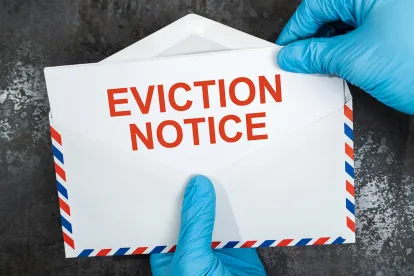In our last report, we discussed the expected wave of eviction proceedings as a result of the pandemic, as nearly 40 million Americans are struggling to pay their rent and housing expenses. Since then, the Trump administration, operating through the Centers for Disease Control and Prevention (CDC), has imposed a sweeping residential eviction moratorium. The CDC’s eviction moratorium bans evictions until December 31, 2020, in hopes of preventing the spread of the virus, as housing advocates warn that mass evictions will force millions of Americans to be crammed in shelters or out on the streets in unsafe conditions amid the pandemic. While this provides relief to certain tenants facing eviction, landlords are dismayed as this further delays eviction proceedings, all while back payments continue to accrue during the pause.
CDC’s Rationale
In the CDC’s regulation setting forth the eviction moratorium, it states that prohibitions on evictions “can be an effective public health measure” to prevent the spread of COVID-19 akin to quarantine, isolation, and social distancing. The CDC also states that a moratorium facilitates self-isolation and allows state and local authorities to more easily implement stay-at-home and social distancing directives. The CDC’s justification also references the public’s interest in preventing homelessness, which increases the transmission of the virus in communal settings, such as homeless shelters where the ability to adhere to social distancing and other infection control measures decreases as its resident populations increase.
What Landlords and Tenants Need to Know
In order for tenants to be eligible, individuals must make less than $99,000 and for those filing jointly, less than $198,000. In addition, sworn declarations must be filed indicating that if evicted, the tenants will face homelessness or be compelled to live in shared living quarters with several others in close proximity. Lastly, they must concede that they attempted to obtain all housing government assistance available to them.
The CDC order will now afford some relief to tenants in the 34 states that do not have similar eviction moratoriums in place. However, the federal CDC order does not apply to any state, local, territorial or tribal area with a moratorium on residential evictions that provides the same or greater level of public-health protection that the requirements listed in the CDC order. For example, Massachusetts’ moratorium provides greater protections and is much broader than the CDC moratorium, as it prohibits imposing late fees and penalties for nonpayment of rent, while the CDC does not. As a result of the greater protections provided by Massachusetts, the CDC order would arguably not apply in that state. However, with Massachusetts’ moratorium set to expire on October 17, 2020 and without an extension, the CDC moratorium may begin to operate in the state.
What Does This Mean for Tenants and Landlords?
While the eviction moratorium does not provide financial relief for renters, there are several state funded programs providing assistance to eligible tenants for rental relief. In addition, there are a number of advocacy and social service organizations assisting individuals with the declarations needed for the CDC moratorium, which has now been translated into almost every language. In addition, public housing authorities are assisting individuals with preparing these declarations and assisting applicants with obtaining rental relief. For renters, it is worth researching their state’s website on COVID-19 housing relief for more information.
Landlords are still able to evict for other reasons such as expiration of the lease. Tenants will still owe any accrued rent and landlords are still able to collect rent from their tenants. Notably, the CDC’s order imposes federal criminal sanctions on those who violate the order and evict for nonpayment of rent, including fines and possible jail time. The federal residential eviction moratorium does not provide renters or landlords monetary relief for the outstanding balances owed, and the lack of funding for rental and unemployment assistance has left landlords disappointed, as they rely on rental income and have continuing financial obligations for keeping up with mortgages, property taxes, and maintenance of their properties. That the moratorium does not address the financial needs of landlords, many landlords are angry and concerned with possible foreclosures in the near future. Until another stimulus is approved which provides relief programs for both landlords and tenants, the crisis remains a hindering problem nationwide.




 />i
/>i

